The Portsmouth Navy Yard, established in 1800, has a long shipbuilding tradition. The shipyard began building submarines during World War I, including the L-8, the first built by a US Navy yard. The yard produced seventy submarines during World War II, launching a record four in one day, and in the 1950s and 1960s built at least ten nuclear subs. In 1953, the yard built the research submarine USS Albacore for testing control systems, dive brakes, sonar equipment, escape mechanisms and other experimental approaches.
Prior submarines had ship-shaped hulls and weren’t particularly maneuverable underwater. Extensive hydrodynamic and wind tunnel testing with an emphasis on underwater speed and maneuverability led to the Albacore‘s revolutionary teardrop-shaped hull design that made her the fastest and most maneuverable submarine of the time and pioneered the American version of the teardrop-shaped hull form. In 1960, the ship went through the second of three major refits to install the pictured experimental, “X”-shaped tail for increased control.
This post is the 18th in the Technology Series. Past posts have included Deer Island Treatment Plant, USS California Distinguished Visitor Embark, Metal Shark Aluminum Boats, the heavy-equipment manufacturer Bell Equipment, and the 2015 Moth World Championships. Click any image for a larger view, or click the position to view the location on a map.
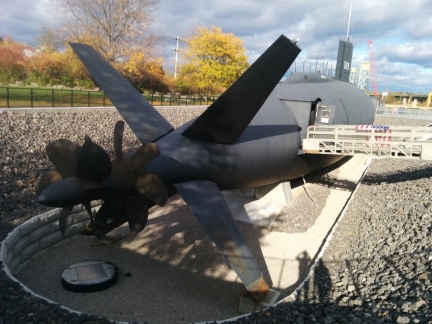 |
USS Albacore
Position: -70 46.05, 43 4.92
The Albacore was retired in 1972 to Philadelphia, and was returned to Plymouth and installed in its current location as a public museum in 1985. Just the engineering challenge of installing a submarine of that size in front of the museum on dry ground is an interesting story. A temporary waterway was constructed, the Albacore floated in, then the waterway was pumped off.
|
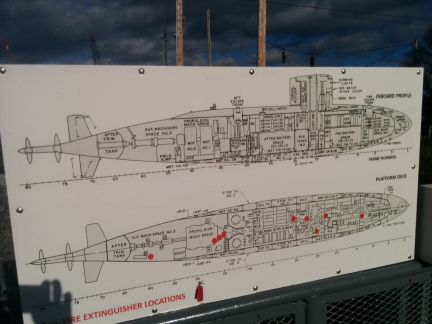 |
Layout
Position: -70 46.00, 43 4.94
The Albacore had a crew of five officers and fifty enlisted men packed into a 205-ft keel jammed with equipment. We were able to tour pretty much everywhere on the ship except for the starboard engine room.
|
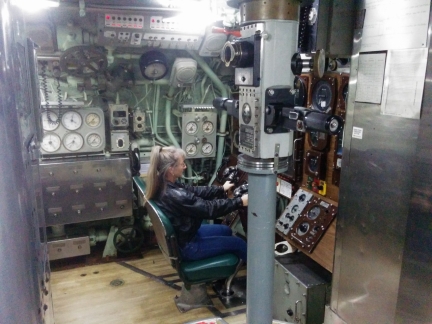 |
Prepare to Dive
Position: -70 46.00, 43 4.94
Jennifer preparing to dive. “Albacore pioneered the single control yoke for bow and stern planes and rudder. Thus, one person (the pilot) was able to perform the functions formerly done by three. By combining other functions, the number of crew members required to dive and operate the boat submerged was reduced from ten to three – the Conning Officer, a pilot and another crew member to operate the blow and vent and trim manifolds. Another Albacore first was the use of a single, multipurpose mast housing a number of antennas. Another Albacore first was the use of a single, multipurpose mast housing a number of antennas. She also carried a single experimental periscope that combined the functions of the thin attack scope and the large aperture search scope.” (The Albacore Story)
|
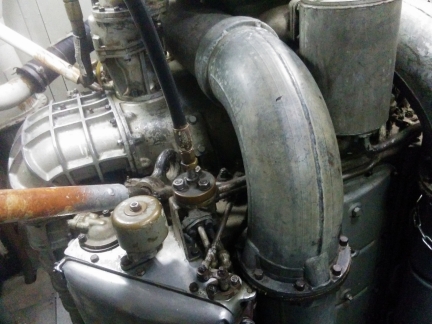 |
Engine
Position: -70 46.00, 43 4.94
One of the General Motors EM 16-184A 16-cylinder, 2-cycle, radial diesel engines of 1,000HP each that charged Albacore‘s batteries. It’s an unusual diesel engine in that there are four banks of four cylinders arranged in an ‘X’ configuration. Reports are they were as unreliable as they were unusual.
|
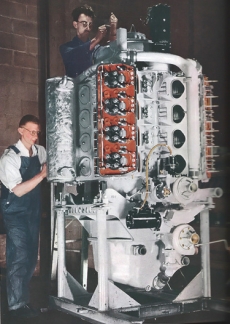 |
EM 16-184A
Position: -70 46.00, 43 4.94
This Old Machine Press picture shows an Electro-Motive-built 16-184A engine similar to the two installed in the Albacore. “The installed pancake diesel engines were a constant aggravation. They were a radical departure from the proven diesels used in earlier boats in that they were made of aluminum and ran at twice the speed of the earlier engines. They were under-powered to charge the ship’s batteries and had a severe tendency to breakdown. But, they were the only engines available that would fit into the cramped space set aside for Albacore‘s engine rooms. It was a cannibalization of the 16 cast-off engines taken from the Tang class of submarines that kept Albacore‘s engines going for 19 years. When those parts were exhausted, Albacore‘s life was over.” (The Albacore Story)
|
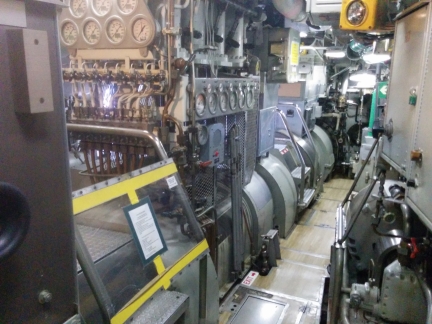 |
Machinery
Position: -70 46.00, 43 4.94
The Albacore‘s aft starboard machinery area. On either side of the steps near the center of the picture are the two General Electric motors that drive the twin counter-rotating props. These are double-armeture, 8,000-amps per armeture, 50-200RPM, 7,500HP electric motors. The two engines are inline with each other and drive two shafts that share the same center, where one shaft is hollow and contains the other shaft. We had a great time on the tour—it was unusual to have such complete access to a vessel.
|
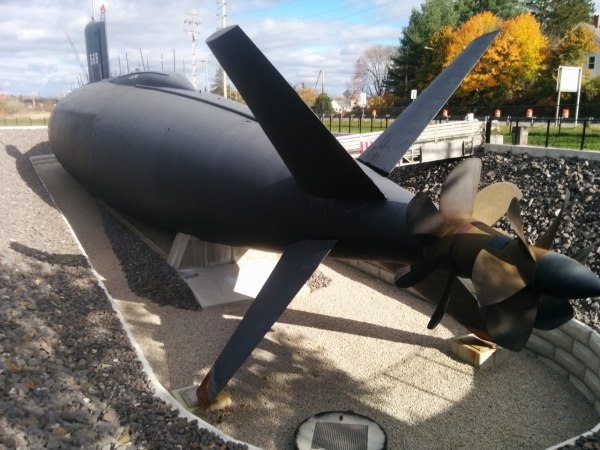
The Albacore was a very enjoyable visit. Particularily with them giving just about full access to the entire vessel. However, it’s not a Virginia class nuclear submarine undeway off the coast of Florida 600′ below the surface. The time I spent on the USS California was incredible an to have been on board during dive operations is a very difficult bar for any other experience to meet. We did really enjoy the Albacore visit though.
How did this compare to the sub you got to go on in FL?